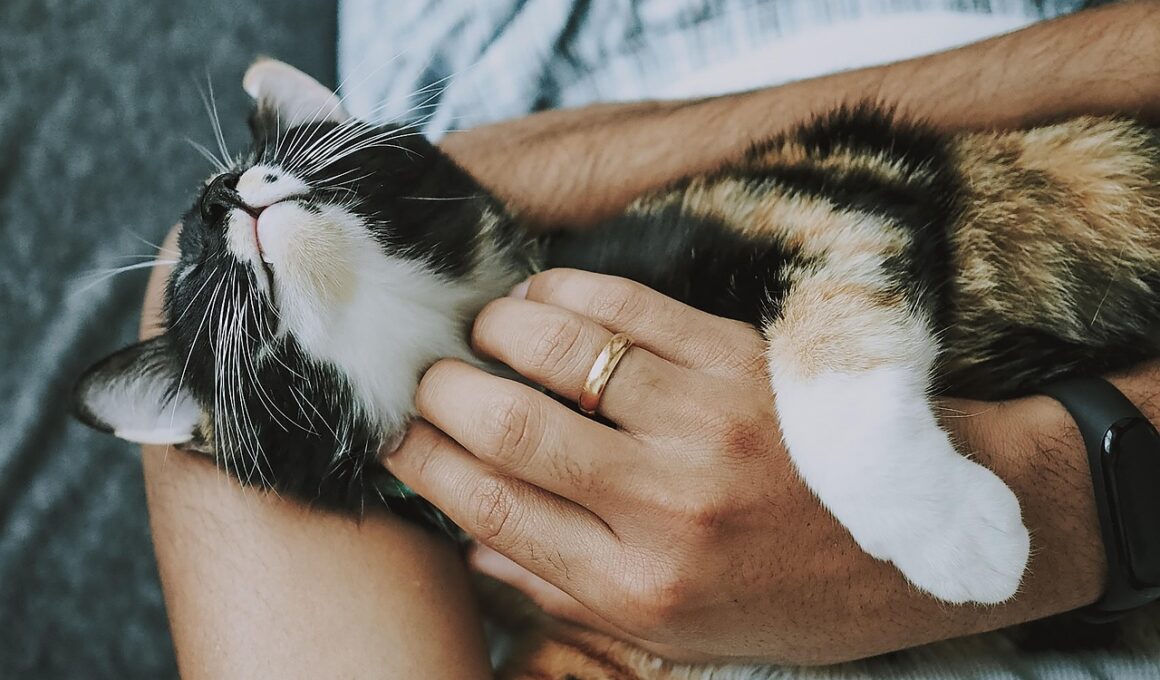Nutrition and Dental Health for Cats in Multi-Cat Living Spaces
In multi-cat households, the importance of proper nutrition and dental health cannot be overstated. Cats, as obligate carnivores, require a balanced diet rich in protein and essential nutrients to thrive. Dental health is a vital aspect of their overall well-being, significantly impacting their quality of life. Poor dental hygiene can lead to various health problems, including periodontal disease. Given that multiple cats may have varied eating habits, it’s essential to monitor their nutrition closely. To maintain optimal dental health, owners should provide dental-specific food options that encourage chewing and help remove plaque. Additionally, consider incorporating dental treats or toys designed to promote oral hygiene. Regular check-ups at the vet ensure any dental issues are addressed promptly. You can also introduce daily tooth brushing as part of your routine, using cat-friendly toothpaste. By staying vigilant about their nutrition and dental care, you can help prevent serious dental issues and contribute to your cats’ long-term health and happiness.
Understanding the Risks in Multi-Cat Households
In multi-cat households, the risk of dental issues can be exacerbated by competition for food and treats. When cats compete, some may eat too quickly, leading to choking or improper chewing, which can exacerbate dental problems. Furthermore, some cats might avoid dry food altogether, preferring canned varieties, which can contribute to plaque buildup. Ongoing challenges in managing dental health include varying preferences for dental care products. Some cats may be resistant to having their teeth brushed or using dental treats, requiring alternative solutions. Automated feeders can help regulate intake, ensuring each cat gets what it needs without competition. Additionally, providing separate spaces for each cat can reduce stress and food rivalry, fostering a better eating environment. Invest in various dental care options and observe your cats’ preferences to ensure compliance. Cats engage differently in their dental hygiene; therefore, discovering the right approach for each cat ensures a more enjoyable experience for everyone. Regular veterinary visits are critical in identifying potential issues early, applying preventive measures to maintain oral health across the household.
Nutrition should primarily focus on high-quality cat food that meets each cat’s specific dietary requirements. Monitor their individual weight and overall condition to adjust diets accordingly. Feeding habits may also differ by age, activity level, and any underlying health conditions. Foods enriched with Omega fatty acids, vitamins, and minerals can support not just overall health, but also oral well-being. In addition to food, fresh, clean water at all times is necessary for hydration, which helps maintain healthy gums and oral tissues. It’s important to regularly clean food and water bowls to reduce bacterial growth that could lead to infections. When selecting food, read labels carefully and look for products with the Veterinary Oral Health Council (VOHC) seal. This seal indicates that the product has passed rigorous testing and is effective in controlling plaque and tartar. Moreover, consider including some natural chewers or dental treats verified for efficacy. Each cat has their unique preferences, so experimenting with diverse food options is crucial to finding the best fit for your feline companions.
Developing a Routine for Dental Hygiene
Establishing a dental care routine for your cats in a multi-cat environment is essential for maintaining their oral health. Regular dental check-ups with a veterinarian should be on your schedule at least once a year. Regular visits allow the vet to recommend specific dental care products or issues to monitor. Owners can create a home dental care routine that includes daily tooth brushing, supplementing with dental treats, and providing chewable toys. Starting slowly with tooth brushing when cats are young or when they’re comfortable can yield better long-term results. Using a finger brush or a soft-bristled cat toothbrush can make the process smoother. Be patient and reward your cats after each brushing session to create a positive association. Alternatively, utilizing dental rinses can offer another method to reduce plaque. Observe your cats and adjust techniques until you find what works for your entire household. Remember, consistent care is key to preventing dental disease, so keep track of their dental habits like you would with their other health areas.
Understanding each cat’s unique dental health needs in a multi-cat household plays an important role in maintaining their hygiene. Some breeds may be more susceptible to dental issues due to genetic factors; therefore, extra attention may be necessary. Keep an eye on changes, including excessive drooling or bad breath, which might indicate underlying dental problems. Regularly monitor each cat’s teeth and gums through gentle examinations during cuddle time, which can also help identify issues before they escalate. Our role includes investing time in dental care and promoting healthy habits. If any cat shows signs of dental distress, seek help from a veterinary professional immediately. Early treatment can prevent more serious health complications later. Providing various interactive toys and dental chews can help engage them, keeping their teeth cleaner. Cat puzzles or feeding toys encourage slower eating, aiding in digestion while also benefiting teeth through natural wear. Furthermore, educate all family members on the importance of dental care to ensure a collaborative effort. Share roles, whether it’s brushing or feeding, to ensure everyone in a multi-cat household contributes to maintaining dental health.
Conclusion: Prioritizing Cat Dental Health
Prioritizing dental health and nutrition for cats in multi-cat households is paramount for their overall well-being. Emphasizing preventive care through routine check-ups and at-home practices ensures healthier, happier lives for your feline friends. Understanding their individual needs allows you to take effective measures to prevent dental issues. Regular feeding routines should be developed to cater to each cat’s unique preferences and requirements. Incorporating varied dental care options, from food to toys, will help keep your household engaged and proactive about oral health. Engaging each cat and rewarding them for their participation will foster better habits and promote a positive atmosphere for everyone involved. As you navigate through the complexities of owning multiple cats, prioritize education, and share information with fellow cat owners. Encouragement can lead to effective practices that enhance overall health, ensuring every cat receives dedicated attention. By investing time in understanding the relationship between nutrition and dental health, you create a stronger bond and a healthier living environment for your cats. Ultimately, their quality of life improves when oral health remains a priority, and wellness becomes a shared objective.
In summary, caring for a cat’s dental health and nutrition, especially in multi-cat households, requires diligence and consistency. By understanding the dynamics and preferences of each cat, owners can create individualized treatment plans that prioritize overall wellness. Monitoring dietary intake, encouraging dental hygiene, and fostering a stress-free environment are all part of a successful strategy. Explore different options to keep your cats engaged and motivated in maintaining their dental health. Be open to incorporating various methods, whether it’s brushing teeth or utilizing dental diets, and don’t hesitate to consult your veterinarian regularly to assess progress. Prioritizing education about feline dental health can empower owners to make informed decisions. Remember, teamwork among family members is essential to maintain your cats’ wellness in a multi-cat environment. By remaining proactive and dedicated to their dental care, you enhance the quality of life for your feline companions while fostering a caring community for their health. Ultimately, a healthy mouth contributes to happy, active, and vibrant cats.
Caring for your cats’ dental health and ensuring they receive proper nutrition should always be a priority in multi-cat households. When you combine education with preventive care measures, you’ll create an environment that encourages healthy habits and reduces stress. By committing to proper techniques and products, you can build strong relationships with each cat while improving their quality of life. Taking small steps like creating a routine and incorporating different dental care options makes the task easier and more enjoyable. Educate yourself on feline dental matters and share tips with fellow cat owners. Promote a community where the well-being of all cats in multiple households ensures collective health benefits. Regular vet consultations and open discussions in your family can establish a comprehensive care plan. A collective effort ensures each feline’s needs are considered. With dedication, awareness, and the right approach, you can improve the dental health of your cats and ensure they lead fulfilling lives free from dental disease, all while enjoying their time together in a harmonious multi-cat household.


